Frontier Centre for Public Policy
They spent $8,000,000 without putting one shovel in the ground
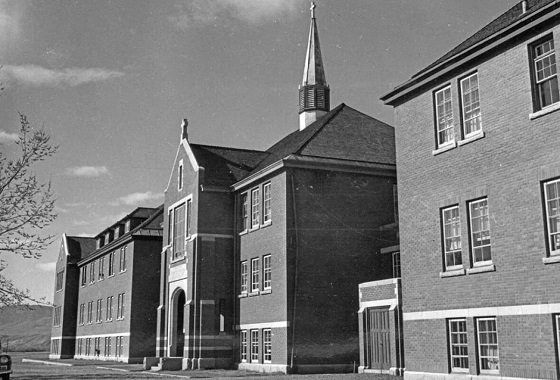
From the Frontier Centre for Public Policy
That’s how much money the Kamloops Band spent on…..exactly what we have no idea. If you remember, that indigenous band claimed that the people running the local residential school had, for unexplained reasons, secretly buried 215 of the students under their care. They had no evidence that would have stood up in any court in the western world to back up that highly unlikely claim. But the federal government immediately gave them $8,000,000 to……well, that’s the mystery. What did they spend that money on? They have not put one shovel in the ground, but apparently they have somehow spent the $8,000,000 of taxpayers’ hard earned money. It was claimed that the money would be used to uncover the “heartbreaking truth”. But the only heartbreaking truth seems to be the complete waste of tax dollars.But it gets worse. A whole lot worse.
Because the Trudeau government- in addition to lowering the flag for six months, and performing teddy bear pantomimes in community ceremonies – then went on to promise not just $8,000,000, but $320,000,000 – to any other indigenous community that wanted to make similar claims.
It should come as no surprise to any sentient being that dozens of poor indigenous communities immediately took the bait and claimed the prize.
So, the result is that hundreds of millions of dollars have been spent somehow. But with no graves found. In fact, none have even put a spade in the ground.
Well, that’s not completely correct. The Pine Creek community in Manitoba was absolutely convinced that the stories about indigenous children dying under sinister circumstances, and being secretly buried under the local church, must be true. After all, they had all heard those stories.
The stories weren’t true. Excavations went ahead, and what was found? Stones.
The stories about priest murders and secret burials are just that. Stories. Meanwhile, hundreds of millions of dollars that should be spent on useful endeavours – like providing better health care for indigenous and non-indigenous Canadians – are being wasted. Rural paramedic services are being constantly cut back, for example. How many rural residents- indigenous as well as non-indigenous- will die from heart attacks because the paramedics were simply too far away from them to get them to the hospital in time to save their lives.There’s no money to improve rural medical services because millions are being wasted searching for phantom “missing children” and “unmarked graves”?
Canadians are beginning to wake up to the fact that they have been had. Somebody is getting rich on all of this government largesse. But it’s not poor indigenous Canadians. They remain stuck on the bottom rung of the socio-economic ladder. And medical and other essential services go wanting, because of this complete waste.
So, are there people in “unmarked graves”?
Absolutely. Billions of them in fact. This planet is basically one huge graveyard. The number of marked graves, with headstones naming the person interred, is a tiny fraction of the billions of people who have died on this planet.
Are the remains of some of the children who died from disease while attending residential school in unmarked graves? Absolutely. For that matter, so are the remains of many of the children who attended day schools, or no school at all in unmarked graves. There is nothing sinister about this fact of life. It simply means that the families of those children did not keep up the graves and cemeteries where the children were interred. (The vast majority of children who died while enrolled in residential schools are buried on their home reserves). This is not a criticism of those families. In fact, some of those families might have died out, and cemetery upkeep became impossible. Others just had different priorities.
So, what we have is just a sad fact of life. Many children died of diseases a hundred plus years ago who would not have died today. Modern medicine is a wonderful thing. And indigenous children died in much greater numbers, for many different reasons. Tuberculosis, in particular, was a major killer of indigenous people.
In fact, tuberculosis is still 290 times higher in the indigenous community than in the mainstream community.
But the fact that death from disease was so much higher in the indigenous community than in the non-indigenous community has nothing to do with residential schools. It has nothing to do with the people running the schools, many of whom devoted their lives to working with indigenous people.
So, we come around to the question – why is $320,000,000 being spent to find the long lost burial places of children, simply because their families decided – for reasons of their own – to not keep up their gravesites? Because it is not true that there are thousands of “missing children” as alleged. Rather, as Professor Tom Flanagan puts it, in “Grave Error”, there are thousands of “forgotten children”. And as the special interlocutor, Kimberley Murray puts it, “These children are not missing, they are buried in local cemeteries”.
Perhaps that’s the reason that Murray’s upcoming National Gathering on Unmarked Burials has been postponed. Because there is nothing to say. Her six figure salary, and those of all of her staff and associates – to say nothing of the $320,000,000 that has been spent – somehow – on searching for phantom graves and phantom “missing children” – could have been better spent on the real needs of living children.
We are approaching the three year anniversary of the Kamloops claim that 215 children from the local residential school had been somehow killed and secretly buried in the apple orchard on the school grounds. There was no good reason to believe that highly improbable claim in the first place. It was only the foolish and emotional reaction of the Trudeau government, and the incompetence of the media that persuaded Canadians that they should take that nonsensical claim seriously in the first place.
It is time to get back to sanity. Treat those who claim – with no real evidence – that priests murdered and secretly buried children – exactly the same way that we treat those who claim that the Martians have landed, or that aliens have abducted their mothers.
Be polite. But don’t finance their delusions.
Brian Giesbrecht, retired judge, is a Senior Fellow at the Frontier Centre for Public Policy
Business
Ford’s Liquor War Trades Economic Freedom For Political Theatre
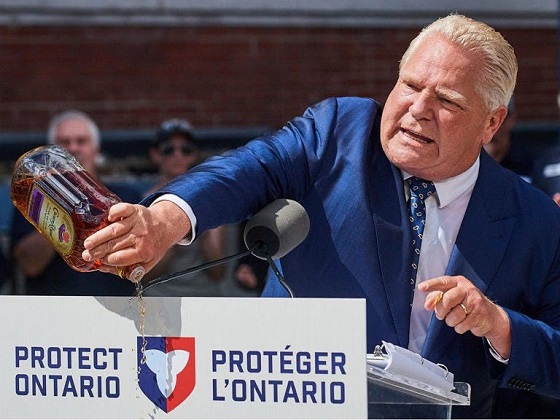
From the Frontier Centre for Public Policy
By Conrad Eder
Consumer choice, not government coercion, should shape the market. Doug Ford’s alcohol crackdown trades symbolic outrage for sound policy and Ontarians will pay the price
Ontario politicians have developed an insatiable appetite for prohibition. Having already imposed a sweeping ban on all American alcohol, Premier Doug Ford has now threatened to remove Crown Royal, Smirnoff and potentially other brands from LCBO shelves. Such authoritarian impulses reflect a disturbing shift in our political culture—one that undermines economic prosperity and individual liberty.
After Diageo, the multinational behind brands like Crown Royal and Smirnoff, announced in August that it would close its Amherstburg, Ont., bottling facility, affecting 200 workers, the political response was swift. NDP MPP Lisa Gretzky urged the government to retaliate by pulling Crown Royal from LCBO shelves. Days later, Ford dramatically dumped a bottle of the whisky during a press conference, signalling he might follow through.
Now, the premier has escalated the threat, vowing to remove Smirnoff and potentially other Diageo products.
These gestures may make headlines, but they come at a cost. They undermine business confidence, discourage investment, and send the wrong message to employers. More fundamentally, they reflect a poor understanding of how free societies settle disputes and make decisions.
To understand what’s at stake, it helps to consider the two basic mechanisms available to democratic societies: the marketplace and the ballot box. At the ballot box, citizens vote once, and majority rule determines a single outcome. The marketplace, by contrast, allows people to vote continuously with their dollars. Individuals make countless choices reflecting their own values and priorities. You get what you choose—without overriding anyone else’s preference.
There’s a role for government in correcting market failures, where there’s fraud, monopoly power or public risk. But banning legal products simply because of political displeasure with a company’s decision is not market correction. It’s coercion.
Diageo’s decision to close a facility may be unfortunate, but it doesn’t involve deception, unfair dominance, or harm to the public. Bans aren’t rooted in sound principle; they’re political, plain and simple.
Some argue the government is justified in acting to protect Ontario jobs. But that line of thinking is short-sighted. If job protection alone warranted banning products, we’d resist every innovation or trade deal that disrupted the status quo. Sustainable job growth depends on encouraging investment and innovation, not shielding every position from change.
The appropriate response to plant closures is policy reform, not retaliation. Ontario should focus on creating an environment where businesses want to invest and grow. That means fostering a stable, competitive business climate with clear rules, reasonable taxes, and efficient regulation. Threatening companies with bans only creates uncertainty and drives investment elsewhere.
With Ontarians spending $740 million annually on Diageo products, removing them from store shelves would impose real economic costs. Consumers would face fewer choices, weaker competition, and higher prices. Restaurants and retailers would be forced to adjust. The LCBO, Ontario’s government-run liquor retailer, would lose sales.
This isn’t hypothetical. The province’s ban on American alcohol is already projected to block nearly $1 billion in annual sales, while doing nothing to benefit Ontario consumers. The LCBO is serving political interests, not the public.
Supporters of such bans often reveal their lack of confidence in public opinion. Rather than persuade others to boycott a product voluntarily, they demand that government enforce a blanket restriction.
There’s a better way. Consumer-led boycotts offer accountability without coercion. They allow individuals to act on their beliefs without forcing others to comply. And they tend to be more effective, as companies respond faster to falling sales than to political theatrics.
But the issue at hand goes beyond liquor. It’s about whether elected officials should impose a single set of preferences on everyone, or whether citizens are trusted to decide for themselves.
Each new ban makes the next one easier to justify. Over time, these interventions accumulate and normalize government interference in private choice. Unlike consumer preferences, which can shift quickly and reverse, government prohibitions often persist. The LCBO’s century-old structure is evidence of how long some policies endure, even when they no longer serve the public interest.
This isn’t a call to eliminate government’s role. But it is a call for principled governance, the kind that distinguishes between legitimate oversight and overreach rooted in symbolism or political frustration.
Ontario’s government would do better to focus on long-term prosperity. That means building an economy where investors feel welcome, businesses can grow, and consumers are free to choose.
Ontarians are perfectly capable of making their own choices about which products to buy and which companies to support. They don’t need politicians like Ford making those decisions for them.
Conrad Eder is a policy analyst at the Frontier Centre for Public Policy.
Frontier Centre for Public Policy
Canada Needs a Mandatory National Service
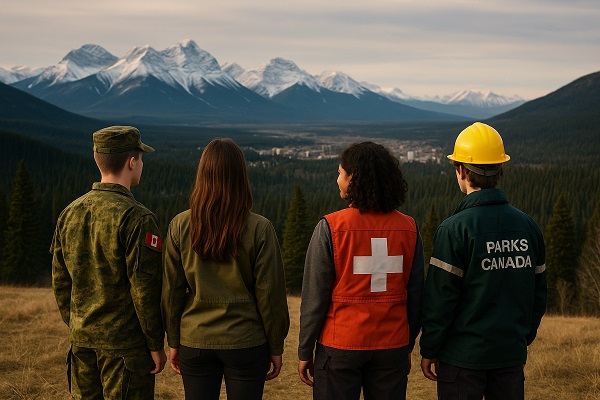
From the Frontier Centre for Public Policy
Retired lieutenant-general and graduate of the Royal Military College of Canada, argues Canada should establish a mandatory national service for all citizens under 30 to rebuild patriotism, civic trust, and national readiness.
Our country can’t defend itself, and citizens aren’t patriotic enough to step up. It’s time to change that.
I joined the military at the age of 18, right out of high school. My parents were working class and couldn’t afford to pay my university tuition, so although I was accepted to several good schools, I chose the Royal Military College of Canada, where I’d be considered part of the military and receive an annual salary. During the academic year, our job was to study. Then in the summer, we did military training. We graduated as second lieutenants—entry-level officers—and then did four years of military service.
I loved RMC. That’s where I learned about discipline, leadership and teamwork. After graduating I served in an armoured regiment in Quebec City, the 12e Régiment blindé du Canada. Eventually, I became a three-star general—a senior commander—and represented Canada in NATO. The military is where I met my wife, who served as a major in the Royal Canadian Air Force. Our experiences gave us a sense of purpose that’s we’ve passed down in our family: today, two of my four kids serve in the Canadian military.
But they’re in the minority. On the whole, the Angus Reid Institute finds that young Canadians are more reluctant to fight for our country than older Canadians, and pride in our armed forces has dropped significantly, from 79 per cent in 2019 to 54 per cent now. That decrease is coupled with a lack of trust in our public institutions. As of 2023, only a third of Canadians were confident in the federal parliament, and barely half reported confidence in the justice system and courts. Some might argue that Canadians are taking more pride in our country now than ever—U.S. President Trump’s tariff threats brought us together and started the “Elbows Up” boycotts—but even that has started to ebb. In any case, we shouldn’t need Trump or any outside influence to make us patriotic. Real patriotism doesn’t come through ideas and slogans, but through leadership and action. That’s why I believe that now, more than ever, Canada needs to create a mandatory national service for all Canadians under 30 years old.
The Canadian Armed Forces are facing a shortage of between 14,000 and 16,000 personnel. Meanwhile, our Arctic coastline is poised to become a site of global geopolitical competition as world powers eye its critical minerals, oil, gas and fresh water. Russian and Chinese interests in the region are expanding, and the ice is melting, opening us up to a looming scramble for northern waterways and seabed resources. If anyone wanted to come into the North and seize our natural wealth right now, there would be little we could do to stop them, short of a strongly worded diplomatic protest. We don’t have the necessary troops to defend ourselves—and the ones we do, we can barely transport up there.
Meanwhile, our country’s political, economic, and military weight has atrophied, and Canada’s international reputation is getting weaker. We’re no longer a strong player on the world stage. For example, in August, when a group of European leaders travelled to Washington, D.C. to discuss the war in Ukraine and support President Zelenskyy, Canada was not at the table—even though we are only a short flight away. We need to rebuild Canadians’ confidence before we can once again wield the weight of a strong middle power abroad. And we can do that by ensuring that Canadians love their country and are prepared to serve it.
The good news is that recent polls show strong interest in a mandatory national service program—especially if it’s broadened beyond the military. In an Angus Reid survey, 43 per cent of people supported the idea of mandatory military service, but about 70 per cent of people approved of a year-long mandatory service in the fields of public health support, environmental support, youth services and civil protection.
There’s much that young people can gain from serving their country. Early in my military career, I spent two years on exchange in France, where I commanded army conscripts. It was the late 1970s, and at the time, almost every 18-year-old male was required to serve in the French military. We received new appelés, or conscripts, right off the bus. They had long hair and lacked any prior military training or knowledge. But after 12 months of basic training, I could have taken my troop to war and won. Some of them, who had shown leadership potential, ended up becoming crew commanders in charge of an armoured vehicle.
These conscripts gained more than just the skills to shoot a rifle or drive a tank; they learned about their country and the importance of defending and serving it. Having a job to do gave them discipline, and they picked up small lessons like the importance of nutrition and staying fit. These basic but foundational habits can help set a person up for life-long health and success.
In France, a lot of the appelés hadn’t travelled much. Once they joined the military, they performed military manoeuvres across the country. When young people get to know their country and its people better, a sense of national pride emerges, along with an understanding of why their country is worth defending in the first place. In Canada, national service could have a similar effect. Imagine a young man or woman from Quebec is sent to serve in Alberta, or vice versa. How much could they learn from that experience?
Several NATO nations already have a mandatory national service system in place, including Lithuania, Estonia, Norway, Finland and Denmark. Lithuania’s system, which seeks volunteers and then uses a lottery to fill the remaining quota, is only for the military and applies to men ages 19 to 26. Estonia conscripts all men between 17 and 27, but other public service jobs are options for those with religious or moral reservations. Meanwhile, Norway’s highly selective conscription program selects several thousand of the most eligible men and women up to the age of 44, granting the nation 3.5 times more military personnel per capita than Canada.
If we’re going to have a national service program, we’ll need leaders in government to create a framework for it. In Canada, the federal government could designate several different streams of work, including defence, conservation, emergency and disaster response, health care, social services, digital infrastructure and youth development. When a young person turns 18, they would register for national service and suggest what stream they might prefer. If more people register than needed, a lottery system could determine who serves and in which stream. Those selected would enter training and take courses on civics and Canadian history, as well as stream-specific skills. They would then be deployed to a community, where they would serve for a year. Deferral beyond age 18 could be an option in some cases, as long as young people still entered service before a certain age, like 25 or 30.
Getting a system like this off the ground would require resources, training capacity and federal coordination, but it would be a worthwhile effort. Canada is faces severe wildfire seasons, an expanding cybercrime landscape and declining biodiversity. Our health-care system is anticipating a shortage of 117,600 nurses by 2030. Young people would emerge from service with a stronger sense of responsibility for their nation and the foundational skills necessary to help address the country’s biggest problems. And of course, those who choose to serve in the military could be added to the reserve, which would place Canada in a stronger position to defend itself in an increasingly aggressive world.
I envision national service as a paying job, which would make it more attractive to young people. And there could be other incentives for them to join—financial support for university, for instance, or guaranteed employment after service. Permanent residents could get a faster path to citizenship.
Citizenship in this incredible country comes with benefits, but also responsibilities. Once every young Canadian has worn a maple leaf on their shoulder, I think they’ll feel pride for their country—something that can unite us all and help Canada achieve its fullest potential.
Michel Maisonneuve is a retired lieutenant-general who served Canada for 45 years. He is a senior fellow at the Frontier Centre for Public Policy and author of In Defence of Canada: Reflections of a Patriot.
-

 Alberta13 hours ago
Alberta13 hours agoFrom Underdog to Top Broodmare
-

 MxM News2 days ago
MxM News2 days agoTrump ‘Grateful’ For Bill Gates Pivot, Declares Victory Over ‘Climate Change Hoax’
-
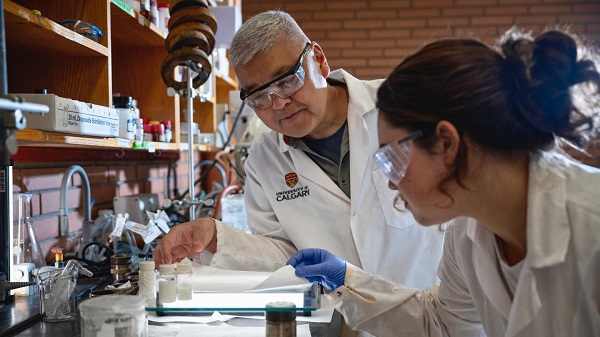
 Alberta2 days ago
Alberta2 days agoNobel Prize nods to Alberta innovation in carbon capture
-

 Business1 day ago
Business1 day agoCanada’s attack on religious charities makes no fiscal sense
-

 International1 day ago
International1 day agoPrince Andrew banished from the British monarchy
-
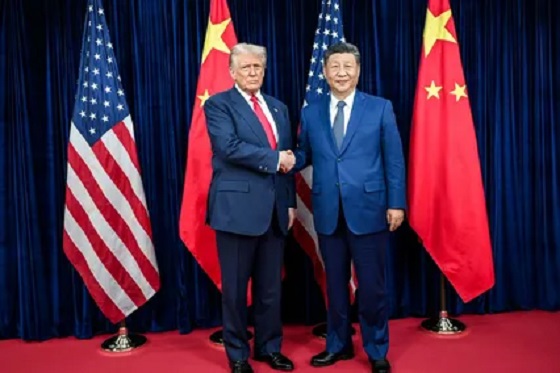
 Business1 day ago
Business1 day ago“We have a deal”: Trump, Xi strike breakthrough on trade and fentanyl
-

 Bruce Dowbiggin2 days ago
Bruce Dowbiggin2 days agoGet Ready: Your House May Not Be Yours Much Longer
-

 Crime24 hours ago
Crime24 hours agoCanada Seizes 4,300 Litres of Chinese Drug Precursors Amid Trump’s Tariff Pressure Over Fentanyl Flows







